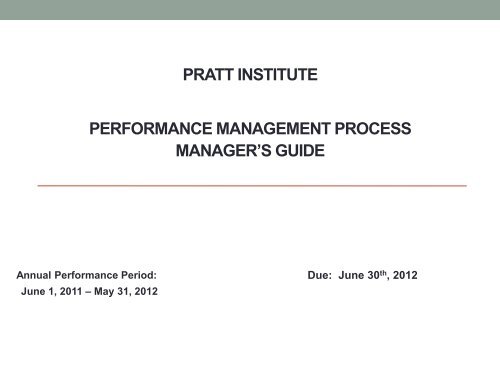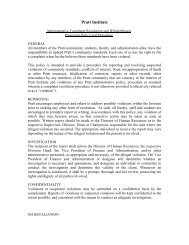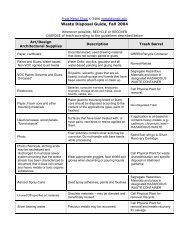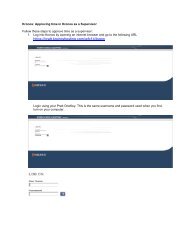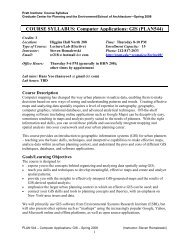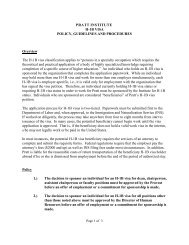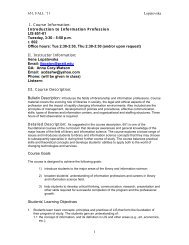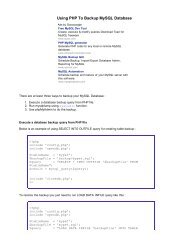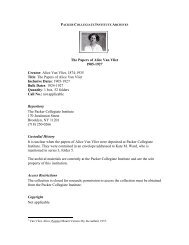Setting Goals - Pratt Institute
Setting Goals - Pratt Institute
Setting Goals - Pratt Institute
You also want an ePaper? Increase the reach of your titles
YUMPU automatically turns print PDFs into web optimized ePapers that Google loves.
PRATT INSTITUTE<br />
PERFORMANCE MANAGEMENT PROCESS<br />
MANAGER’S GUIDE<br />
Annual Performance Period:<br />
June 1, 2011 – May 31, 2012<br />
Due: June 30 th , 2012
2<br />
Agenda<br />
Page(s)<br />
Agenda 2<br />
Why do Appraisals 3<br />
Shared Process 4<br />
Timeline 5<br />
Plan and Prepare 6<br />
WingSpan Overview 7<br />
WingSpan Login 8<br />
WingSpan Appraisal Process 9<br />
Rating Tendencies 10 - 11<br />
Conducting the Appraisal Meeting 12-13<br />
<strong>Pratt</strong>’s Strategic Plan for 2012-2017 14<br />
Diagram – Goal <strong>Setting</strong> 15<br />
<strong>Setting</strong> <strong>Goals</strong> 16<br />
Sample <strong>Goals</strong> 17<br />
Human Resources 18-19<br />
Q & A 20
3<br />
Appraisals serve several important purposes:<br />
• measuring employee performance and progress<br />
• providing an employee with constructive feedback<br />
• identifying goals and objectives for an employee<br />
• creating guidelines for improvement in areas that need further development<br />
• providing support for personnel actions (e.g. salary increase, promotion, etc.)<br />
Supervisor<br />
• encourage optimal work performance of employees<br />
• align individual goals with <strong>Institute</strong> goals and objectives<br />
• identify any obstacles and methods to aid employee’s work performance<br />
• enhance employee/supervisor communication<br />
• discuss employee career development and note progress<br />
Employee<br />
• help to see role in organization<br />
• opportunity to provide feedback to supervisor<br />
• identify strengths for possible advancement<br />
• receive direction on areas to develop
4<br />
Shared Process<br />
Appraisal review is a shared process<br />
The employee and supervisor both contribute and share responsibility for<br />
completing their respective reviews, identifying potential goals and preparation<br />
for a constructive dialogue in the appraisal meeting.<br />
It is important that employees participate fully, ask questions and make candid<br />
comments during the meeting and within the written performance review.<br />
The purpose of the meeting is to promote increased communication and<br />
understanding between the employee and supervisor through discussion of the<br />
employee’s work performance and the joint planning of future goals.
5<br />
Timeline<br />
• supervisor drafts review while employee completes self-assessment<br />
• schedule appraisal meeting once supervisor review and self-assessment<br />
are done<br />
• discuss employee work performance and jointly identify future goals for<br />
employee at meeting<br />
• finalize appraisal and goals<br />
• secure next level approval if necessary<br />
• employee confirms on Wingspan that meeting was held and they are in<br />
receipt of appraisal<br />
• employee has the opportunity to comment on final rating<br />
• all steps of the process should be completed by June 30 th<br />
• extensions may be granted if necessary
6<br />
Plan and Prepare<br />
Gather pertinent reference material to use as<br />
illustrative examples, situations and documentation<br />
that support the appraisal and rating<br />
• job description<br />
• goals and objectives from prior year<br />
• previous performance reviews<br />
• communications: e-mails, correspondence to/from<br />
employee<br />
• documentation: meeting notes, employee reports,<br />
work samples, letters of commendation, awards,<br />
complaints, warnings, etc.<br />
• weigh feedback from colleagues, students, staff,<br />
clients, et al. familiar with employee’s work<br />
performance
7<br />
WingSpan Overview<br />
Introduced in 2010<br />
automated, integrated employee performance database<br />
Advantages:<br />
• easier to manage<br />
• less time-consuming<br />
• reduces paper<br />
• ready access to performance review history and reports<br />
• allows tracking progress and identification of performance trends<br />
• single resource for performance data
8<br />
WingSpan Login<br />
1. click on link in e-mail mailed to<br />
employees; or<br />
2. log into: My.<strong>Pratt</strong> Website<br />
Human Resources<br />
Performance Review<br />
WingSpan link; or<br />
3. type in address line …<br />
https://pratt-ws.silkroad.com/pratt
9<br />
WingSpan Appraisal Process<br />
Begins<br />
Employee Writes Self-Assessment/Supervisor Drafts Appraisal<br />
Employee and Supervisor View Other’s Appraisal/Assessment<br />
Supervisor and Employee Meet to Discuss Appraisal and <strong>Goals</strong><br />
Supervisor Finalizes Appraisal and Sets <strong>Goals</strong><br />
Next Level Manager Approves Appraisal and <strong>Goals</strong> (if necessary)<br />
Both Employee and Supervisor Acknowledge Meeting and Completion of Process
10<br />
Rating tendencies to avoid…<br />
‣ Recency Effect/Sampling Error<br />
• basing an entire review on just the last few months or a specific incident<br />
It is a common tendency for supervisors to give too much weight to an employee’s recent work performance or a<br />
single notable issue since it is fresh in the supervisor’s mind and easier to recall. It is important to give a<br />
comprehensive and balanced review of the employee’s performance throughout the entire review period. It is helpful<br />
to keep track of your employees on a regular basis and keep a record of any projects they are working on. Keep<br />
notes, work samples, etc. for your employees throughout the year to chart their accomplishments and also note their<br />
progress.<br />
‣ Halo/Horns Effect<br />
• addressing only one particular performance area and generalizing it to the entire evaluation<br />
It is crucial to give employees a fair and accurate assessment of all aspects of their work performance so they are<br />
aware of and can address their relative strengths and weaknesses. An employee may excel in one area but need<br />
improvement in another. Employees likely won’t develop their skills and abilities sufficiently if they are not given an<br />
accurate and full picture of how they are doing.<br />
‣ Leniency Bias<br />
• giving overly generous ratings<br />
There can be a tendency for supervisors to give inflated performance ratings to employees, to avoid a difficult<br />
conversation with the employee and having to give constructive criticism. This dilutes the integrity of the appraisal<br />
and often leads to increased performance issues if employees aren’t counseled on what they need to work on.<br />
Performance reviews should include honest and straightforward feedback to the employee.<br />
‣ Strictness Bias<br />
• rating employees too harshly<br />
• Conversely some supervisors are too hard in evaluating employees. This can backfire by demoralizing employees<br />
who may feel their contributions are not fully recognized or appreciated. Although constructive criticism is important,<br />
the appraisal should also be balanced and acknowledge where the employee has done well.
11<br />
rating tendencies to avoid continued…<br />
‣ Central Tendency Bias<br />
• rating all employees as average or in the middle<br />
• Supervisors may try to avoid any controversy and play it safe by rating all employees in the middle and thus avoid<br />
having to give justification for ratings at either extreme. This robs the employee of a fair and honest evaluation and<br />
likely will alienate the best employees and absolve the struggling employee from having to improve their<br />
performance.<br />
‣ Comparing<br />
• evaluating employee in comparison to another employee<br />
• It can be tempting or convenient to consider an employee’s performance in comparison to another, presumably<br />
stellar, employee but it is likely to be demoralizing and leave the 1 st employee feeling lesser than. It is important to<br />
evaluate the employee on his/her own merits based on a fair assessment of how he/she performed her job and met<br />
expectations, recognizing his/her unique attributes.<br />
‣ Mirroring<br />
• evaluating an employee based on the supervisor’s own qualities<br />
• Supervisors may, often subconsciously, place too much emphasis on their own perceived skills and abilities, and use<br />
that as a standard in evaluating employees. Again this creates a standard of performance to evaluate the employee<br />
that may not be relevant to the employee and deprives the employee of a fair assessment.<br />
• All of these tendencies are essentially shortcuts for a supervisor and interfere with employees receiving an honest<br />
and fair assessment of their work performance which ultimately harm the employee and <strong>Pratt</strong>.
12<br />
Conducting the Appraisal Meeting<br />
Scheduling the meeting<br />
• set aside sufficient time for full discussion<br />
• be considerate of the employee’s time as well as your own<br />
• avoid interruptions, cancellations, rescheduling<br />
State the purpose and format of the appraisal meeting<br />
• focus on development of employee, non-punitive nature of performance review<br />
Promote candid employee participation<br />
• privacy of meeting place, discretion<br />
• ask the employee for his/her own thoughts about areas of strength, employee development,<br />
potential goals, and any performance issues<br />
• avoid diagnosing any problems<br />
• use caution in discussing employee’s attitude or personality – focus on behaviors and facts<br />
• be non-judgmental<br />
Respect the employee<br />
• create a comfortable, non-threatening environment<br />
• allow employee to give their opinion and disagree with your review<br />
• seek clarification if necessary<br />
• don’t interrupt
13<br />
Conducting the Appraisal Meeting (Cont’d)<br />
Be prepared for negative employee responses<br />
• defensiveness, making excuses<br />
• anger, venting<br />
• silence, withdrawal<br />
• give the employee some leeway<br />
• be patient<br />
• maintain composure, avoid reacting or arguing<br />
• steer the focus back to employee’s work performance<br />
• remind employee of the purpose of the meeting<br />
• note that the employee is unresponsive and encourage respectful participation<br />
• remind employee of the value and importance of his or her input<br />
• ask the employee for possible solutions
14<br />
The Goal <strong>Setting</strong> Process helps to integrate and align goals across the <strong>Institute</strong><br />
<strong>Pratt</strong> <strong>Institute</strong><br />
Strategic Plan<br />
Division <strong>Goals</strong><br />
Departmental <strong>Goals</strong><br />
Administrative<br />
Staff <strong>Goals</strong>
15<br />
<strong>Pratt</strong>’s Strategic Plan<br />
2012 - 2017<br />
<strong>Pratt</strong>’s Strategic Plan for 2012 - 2017 was presented on May 1 st , 2012 to the <strong>Pratt</strong> Community.<br />
There are 4 major organizing themes within the strategic plan:<br />
• Enriching the Academic Experience<br />
• Expanding Horizons<br />
• Creating Dynamic Environments<br />
• Building Capacity<br />
The <strong>Institute</strong>’s strategic goals are organized under these 4 themes. Academic and administrative<br />
offices will use the Strategic Plan spreadsheet as a working document to develop annual tasks<br />
and to track their progress. Supervisors and employees can formulate employee performance<br />
goals from these tasks.<br />
Theme<br />
Goal<br />
Objective<br />
Task<br />
‣ Employee Goal
16<br />
<strong>Setting</strong> <strong>Goals</strong><br />
having 3-5 broad goals for the employee is appropriate<br />
both supervisor and employee suggest goals<br />
employee should be encouraged to suggest some of<br />
his/her own goals<br />
setting goals should be mutual process between the<br />
employee and supervisor with frank discussion in the<br />
appraisal meeting
17<br />
Employee <strong>Goals</strong><br />
Samples:<br />
Human Resources Department<br />
1. HR Director Goal: Create an annual staff evaluation system (from 2006-2011<br />
Strategic Plan) and proceed with evaluations.<br />
a) 2012: Revise Performance Evaluation system to address supervisor<br />
concerns and improve completion rate. Modify online performance review<br />
form and develop performance evaluation training program for supervisors.<br />
This goal falls under a larger goal identified in the strategic planning process:<br />
• Increase the transparency of policies and procedures to clarify<br />
expectations and improve accountability and perception of<br />
departments.<br />
2. HRIS Manager Goal: Selection and implementation of online time &<br />
attendance system (Kronos).<br />
This goal falls under a larger goal identified in the strategic planning process:<br />
• Consolidate and automate business processes and functions to<br />
increase efficiency and improve customer service.
18<br />
Human Resources<br />
We are here to assist you and provide guidance<br />
regarding any issues that may arise including:<br />
• The appraisal meeting process or preparation<br />
• Rating pitfalls<br />
• Reviewing draft appraisals<br />
• Assistance in creating a performance improvement plan.<br />
• WingSpan – navigation, access, creating a productive<br />
performance management tool<br />
• Addressing employee issues before they become<br />
significant problems.
19<br />
Human Resources Department<br />
x 3787<br />
Thomas Greene<br />
Amy Hecht<br />
Steven McDaniel<br />
Mary Erazo<br />
Veinia Eubanks
20<br />
2012<br />
Performance<br />
Appraisal<br />
Meetings<br />
Q & A
Thank You!<br />
21


